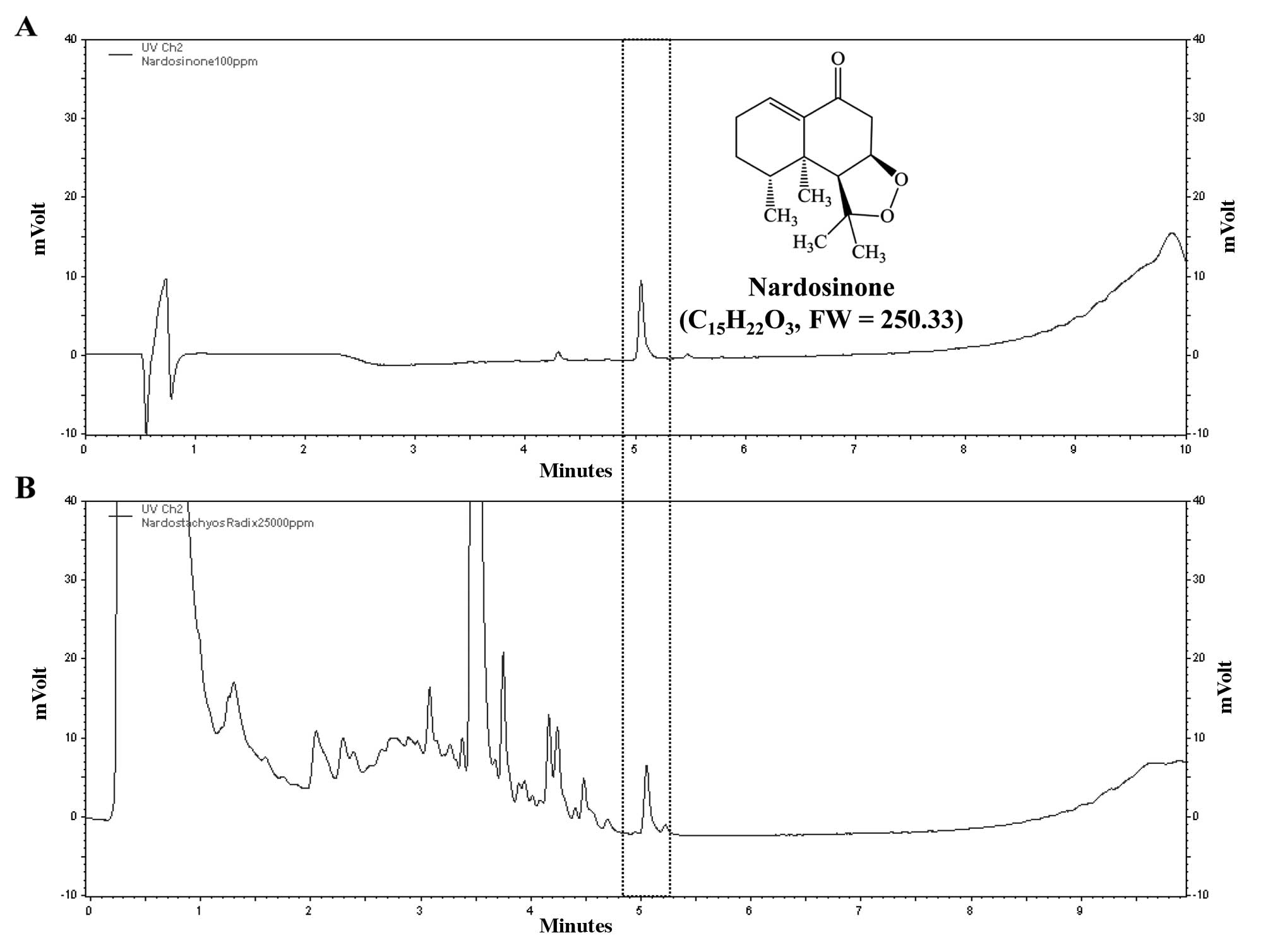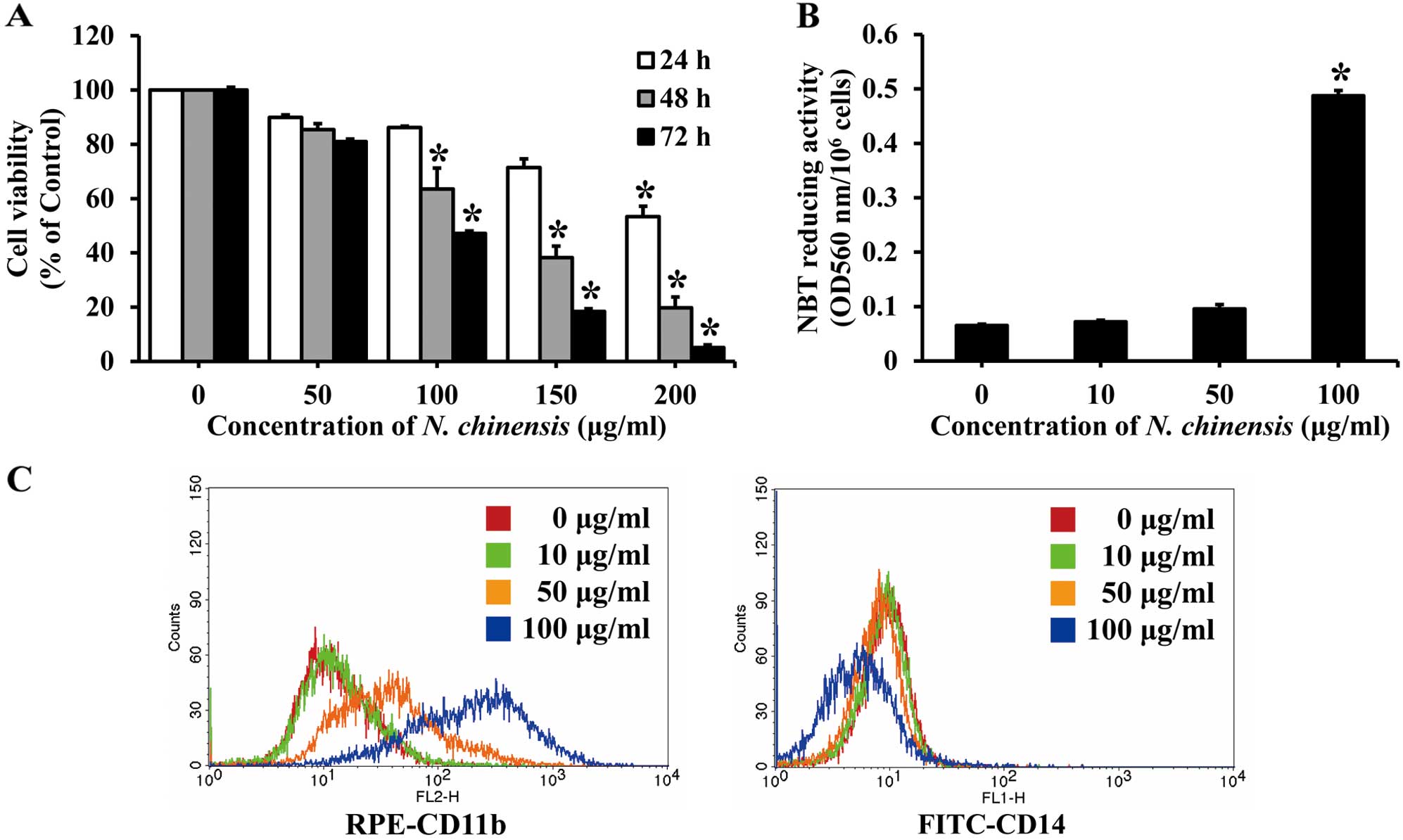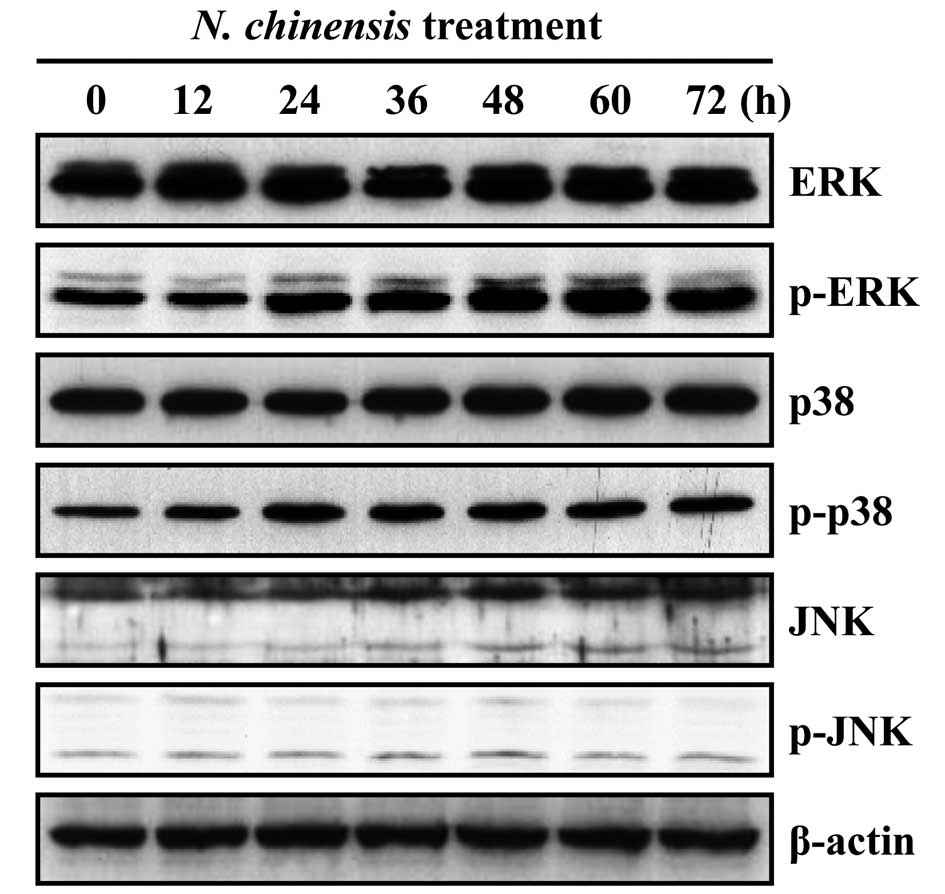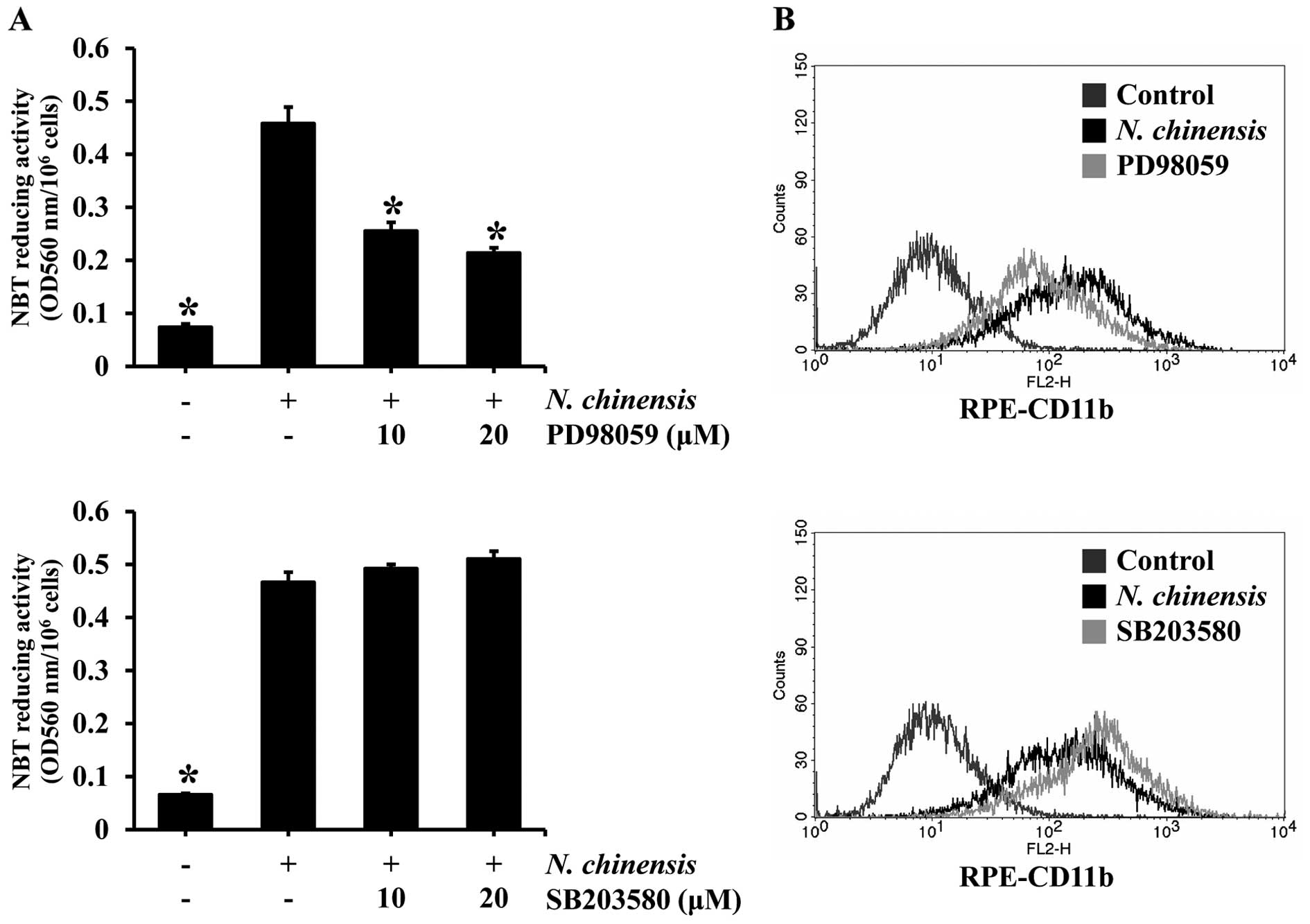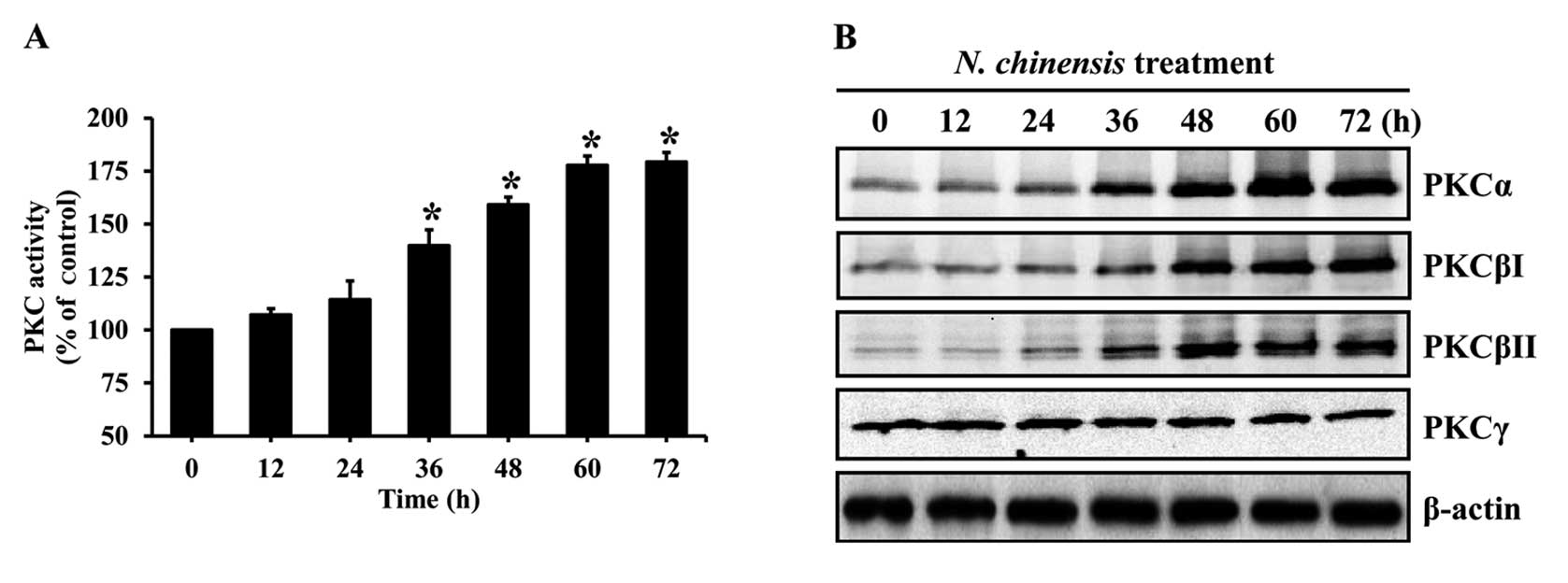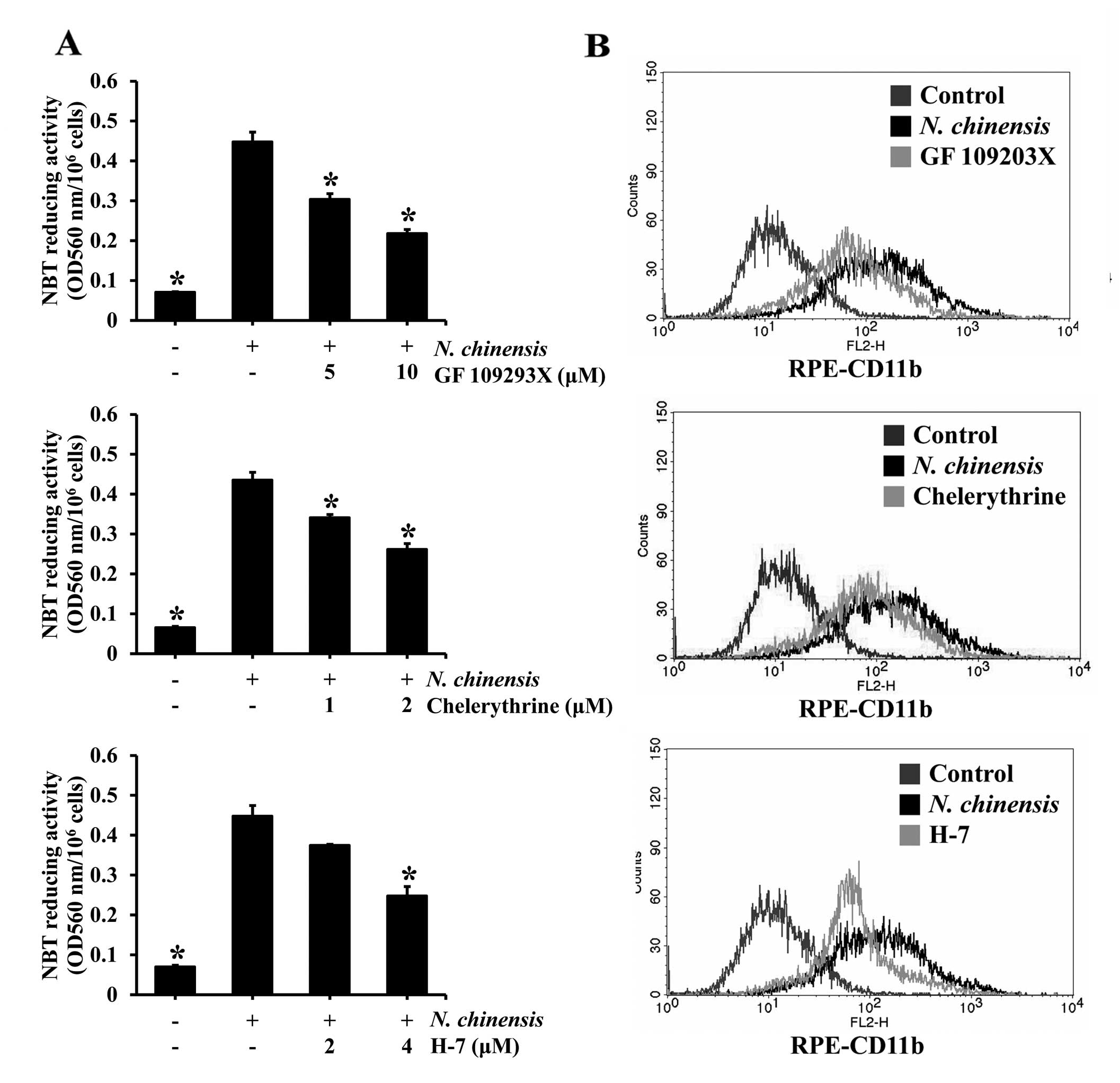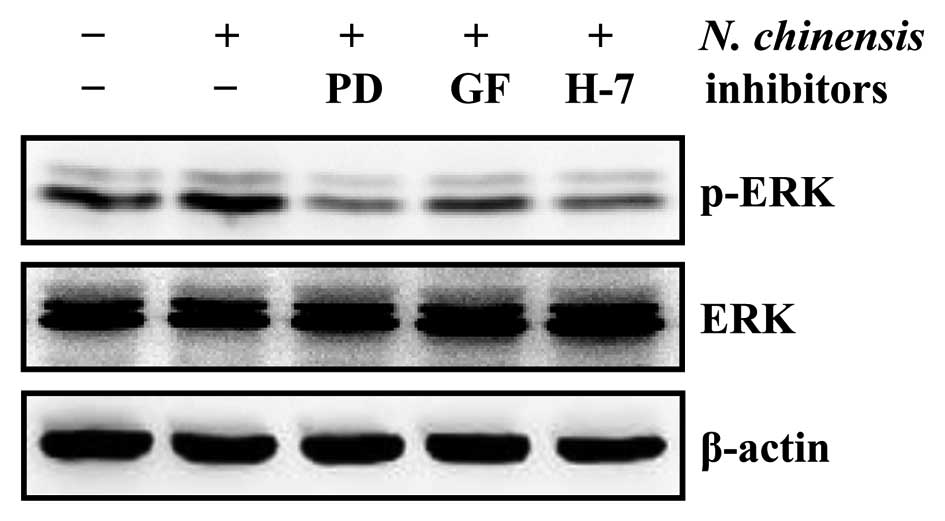Nardostachys chinensis induces the differentiation of human promyelocytic leukemic cells through the activation of the protein kinase C-dependent extracellular signal-regulated kinase signaling pathway
- Authors:
- Published online on: December 19, 2013 https://doi.org/10.3892/ijmm.2013.1596
- Pages: 573-580
Abstract
Introduction
The underground parts of Nardostachys chinensis (N. chinensis), which belongs to genus Valerianaceae, have been used in traditional Korean medicine for centuries to elicit stomachic, anti-arrhythmic and sedative effects (1). This plant is known to be rich in sesquiterpenoids (2), which have been shown to exhibit antimalarial, antinociceptive (3) and cytotoxic activities (4). Nardosinone, isolated from N. chinensis has been shown to act as an enhancer of nerve growth factor in neuronal cells (5) and to possess anti-inflammatory properties in lipopolysaccharide (LPS)-stimulated macrophages (6).
HL-60 cells differentiate into either macrophage/monocytic (7,8) or granulocytic lineages (9), depending on the type of stimuli. The induction of the differentiation of HL-60 cells has been shown to be associated with the activation of various protein kinases, including isoforms of protein kinase C (PKC) and mitogen-activated protein kinases (MAPKs) (10–13). MAPKs are serine/threonine kinases that are involved in the regulation of a variety of cellular responses, such as cell proliferation, differentiation and apoptosis (14,15). Based on structural differences, they are classified into three subfamilies: extracellular signal-regulated kinase (ERK), c-Jun N-terminal kinase (JNK) and p38 MAPK kinase. The ERK signaling pathway is mainly activated by mitogens and growth factors, and plays a major role in the regulation of cell growth, survival and differentiation (16,17). By contrast, the JNK and p38 MAPK pathways are activated in response to chemicals and environmental stress, and are frequently associated with the induction of apoptosis (17,18). In the leukemic cell line, HL-60, the activation of MAPKs has been shown to be involved in monocytic and granulocytic differentiation (19–23). Specifically, ERK activation is required for the differentiation of leukemic cells into monocytes and granulocytes (19–21). While JNK activation is associated with monocytic differentiation (22,23), p38 MAPK activation is involved in the inhibition of monocytic differentiation (23).
PKC is considered a potential target for the development of novel anticancer therapeutic agents. PKC plays a key role in the regulation of the response of hematopoietic cells to physiological and pathological inducers of proliferation and differentiation (24,25). The 12 PKC isoforms identified to date are classified into three distinct groups on the basis of the presence of functional domains and subsequent differences in their regulation: i) the conventional isozymes (cPKCs: α, βI, βII and γ) are diacylglycerol- and calcium-dependent; ii) the novel isozymes (nPKCs: δ, σ, η, θ and μ) are diacylglycerol-dependent and calcium-independent; and iii) the atypical PKC isozymes (aPKCs: ξ, ι and λ) are diacylglycerol- and calcium-independent (26). Of the PKC isoforms, the calcium-dependent PKC isozymes are most abundantly expressed in leukemic cells and have been implicated in the induction of the differentiation of HL-60 cells (27).
Since PKC and MAPKs have been implicated in the induction of the differentiation of leukemic cells, in this study, we investigated whether N. chinensis extract induces the differentiation of HL-60 cells through the activation of PKC and MAPKs.
Materials and methods
Reagents and antibodies
3-(4,5-Dimethyl-2-thiazolyl)-2,5-diphenyl-2H-tetrazolium bromide (MTT), nitrotetrazolium blue chloride (NBT), phorbol 12-myristate 13-acetate (PMA), protease inhibitor cocktail, and anti-β-actin were purchased from Sigma-Aldrich Chemical Co. (St. Louis, MO, USA). 2′-Amino-3′-methoxyflavone (PD98059), 4-(4-fluorophenyl)-2-(4-methylsulfonylphenyl)-5-(4-pyridyl) 1H-imidazole (SB203580), bisindolylmaleimide (GF 109203X), chelerythrine chloride and 1-(5-isoquinolinesulfonyl)-2-methylpiperazine dihydrochloride (H-7) were purchased from Calbiochem (La Jolla, CA, USA). Methanol, acetonitrile and water of high-performance liquid chromatography (HPLC) grade were obtained from Fisher Scientific Co. (Pittsburgh, PA, USA). Nardosinone was purchased from Sichuan Weikeqi Biological Technology Co., Ltd. (Chengdu, Sichuan, China) at >98% purity. RPMI-1640, fetal bovine serum (FBS) and antibiotic-antimycotic solution were purchased from Gibco (Grand Island, NY, USA). RPE-conjugated anti-CD11b and FITC-conjugated anti-CD14 antibodies were purchased from Dako (Glostrup, Denmark). Anti-ERK, anti-phosphorylated (p)-ERK, anti-p38, anti-p-p38, anti-JNK and anti-p-JNK antibodies were purchased from Cell Signaling Technology Inc. (Beverly, MA, USA). Anti-PKCα, anti-PKCβI, anti-PKCβII and anti-PKC γ antibodies were purchased from Santa Cruz Biotechnology, Inc. (Santa Cruz, CA, USA).
Preparation of N. chinensis extract
The dried roots and stems of N. chinensis were purchased from Nonglim-Saengyak Co., Ltd. (Seoul, Korea). N. chinensis was identified by Professor B.-H. Jeon and Professor G.-S. Lee, two of the authors. A voucher specimen (DP-2012-NC) has been deposited at the Department of Pathology, College of Korean Medicine, Wonkwang University, Iksan, Korea. An aqueous extract was prepared by boiling 100 g of N. chinensis with one liter of distilled water for 2 h, and then centrifuged at 2,000 rpm for 15 min to remove the insoluble ingredients. The supernatant was filtered through Whatman filter paper no. 4 in a Büchner funnel under a vacuum and stored at −20ºC overnight. The frozen extract was freeze-dried in a vacuum chamber. The yield of the extract was 12.82% (w/w). The freeze-dried powder was then dissolved in PBS (pH 7.4) at a concentration of 40 mg/ml and stored at −20ºC; it was diluted in cell culture medium prior to use.
HPLC analysis of N. chinensis extract
The aqueous extract of N. chinensis was analyzed by liquid chromatography (LC) using a SmartLC sytsemt (LC800series; GL Sciences, Tokyo, Japan) equipped with an Inertsil ODS-4 column (2.1×50 mm, 2 μm ID) at 35ºC. The mobile phase consisted of water (solution A) and acetonitrile (solution B). A gradient of the mobile phase was used as follows: 10% solution B for 1 min, 10–90% solution B for 1–9 min. The final concentration of nardosinone dissolved in methanol was 0.1 mg/ml and that of the N. chinensis extract dissolved in water was 25 mg/ml. The flow rate was set to 0.4 ml/min and the injection volume was 1 μl. The wavelength for the detection of nardosinone was 280 nm. The acquired data were processed using EZChrom Elite software version 3.3.2 SP1 (Agilent Technologies, Santa Clara, CA, USA). The nardosinone peak was detected at 5.051 min retention time and the water extract of N. chinensis had the same retention time (Fig. 1).
Cell culture
HL-60 cells were obtained from the American Type Culture Collection (ATCC; Rockville, MD, USA) and cultured in RPMI-1640 medium supplemented with 10% FBS and an antibiotic-antimycotic solution at 1:100 dilution, at 37ºC in a humidified 95% air and 5% CO2 incubator.
Determination of cell viability
Exponentially growing cells were seeded into 24-well plates (1×105 cells/well) in duplicate. The cells were treated with increasing concentrations of N. chinensis extract for 24, 48 and 72 h. Following treatment, each well was incubated with 100 μl of 5 mg/ml MTT for 4 h. Water-insoluble MTT-formazan crystals were solubilized by the addition of an equal volume of solubilization solution (10% SDS, 0.01 N HCl) and overnight incubation in a humidified atmosphere of 5% CO2 at 37ºC. The amount of formazan was determined at 570 nm using a SpectraMax 250 Microplate spectrophotometer (Molecular Devices, Sunnyvale, CA, USA). The relative percentage of viable cells was calculated using the following equation: % cell viability = [mean optical density (OD) of treated cells/mean OD of control cells] ×100.
NBT reduction assay
HL-60 cells (1×106 cells/60-mm dish) were cultured in RPMI-1640 medium containing N. chinensis extract and 10% FBS for 72 h, and then the NBT reducing activity of the cells was determined by the method described in the study by Sakashita et al (28) with a slight modification. Briefly, the cells were harvested by centrifugation and suspended in 200 μl of 2 mg/ml NBT solution. Following the addition of 2 μl of 100 μg/ml PMA solution, the cell suspension was incubated at 37ºC for 20 min, and 200 μl of 1 N HCl were added at 4ºC to terminate the reaction. Following centrifugation, 600 μl of DMSO were added to the cell pellets to solubilize the formazan crystals. The amount of formazan was determined at 560 nm using a SpectraMax 250 Microplate spectrophotometer.
Flow cytometric analysis
The HL-60 cells treated with N. chinensis extract were harvested, washed twice with ice-cold PBS (pH 7.4), and then suspended in 100 μl of PBS containing 0.25% BSA. After the addition of 10 μl of RPE-conjugated anti-CD11b or FITC-conjugated anti-CD14 antibodies, the cells were incubated in the dark at 4ºC for 30 min, washed twice with PBS containing 0.25% BSA and fixed in 500 μl of PBS containing 1% formaldehyde. The levels of antibody binding to the cells were quantified using fluorescence-activated cell sorting (FACS) technology on a FACSCalibur flow cytometer (BD Biosciences, San Diego, CA, USA).
Western blot analysis
Cells were washed with ice-cold PBS (pH 7.4), gently resuspended in ice-cold lysis buffer (50 mM Tris-HCl at pH 7.4, 150 mM NaCl, 1% NP-40, 0.5% sodium deoxycholate, 0.1% SDS and 1% protease inhibitor cocktail), and incubated on ice for 30 min. Cell lysates were centrifuged for 10 min at 14,000 rpm at 4ºC, and the protein concentration was determined by Bradford assay. Samples containing 40 μg of total protein were resolved in a SDS-PAGE gel, and transferred onto a nitrocellulose membrane for 3 h at 40 V. The membrane was probed with primary antibodies and immunoreactivity was detected using HRP-conjugated goat anti-rabbit IgG or rabbit anti-mouse secondary antibodies. Immunoreactive bands were visualized using the SuperSignal West Pico Chemiluminescent substrate by Thermo Fisher Scientific Inc. (Waltham, MA, USA) and were quantified using the Molecular Imager ChemiDoc XRS system (Bio-Rad, Hercules, CA, USA).
PKC activity assay
PKC activity was measured using a PKC Kinase Activity Non-Radioactive Assay kit (Stressgen Biotechnologies Corp., Victoria, BC, Canada) as follows: the cells were washed with ice-cold PBS (pH 7.4), and lysed on ice for 5 min in sample preparation lysis buffer (20 mM MOPS, 50 mM β-glycerolphosphate, 50 mM NaF, 1 mM sodium vanadate, 5 mM EGTA, 2 mM EDTA, 1% NP-40, 1 mM dithiothreitol and 1% protease inhibitor cocktail), and centrifuged at 13,000 rpm for 15 min at 4ºC. The protein concentration was determined by Bradford assay. Lysed protein extracts (500 ng) were diluted into 30 μl of the dilution buffer and loaded on 96-well plates coated with a PKC substrate peptide. The PKC assay was initiated by the addition of 10 μl of adenosine triphosphate (ATP; 1 mg/ml) to each well at 30ºC, and the incorporation of phosphate into the substrate peptide was measured as per the manufacturer’s instructions after 1 h. The wells were then washed twice with antibody dilution buffer, and 40 μl of phospho-specific substrate antibodies were added to each well followed by incubation for 1 h. Each well was subsequently washed four times for 10 min with washing buffer and a 1:1,000 dilution of anti-rabbit IgG HRP-conjugated antibody in the kit’s dilution buffer, and incubated for 30 min. The wells were washed four times, and 60 μl of tetramethylbenzidine substrate was added and the wells were incubated for 30 min. The HRP reaction was quenched with the addition of 20 μl of acid stop solution and the absorbance of each well was measured at 450 nm using a SpectraMax 250 Microplate spectrophotometer. The relative percentage of PKC activity was calculated using the following equation: % PKC activity = (mean OD of treated cells/mean OD of control cells) ×100.
Statistical analysis
Statistical analysis was performed using Microsoft Office Excel 2010 (Microsoft, Redmond, WA, USA). The data are expressed as the means ± standard deviation (SD). Statistically significant differences between groups were assessed by the Student’s t-test.
Results
Effects of N. chinensis extract on the proliferation and differentiation of HL-60 cells
The effects of N. chinensis extract on cell proliferation were evaluated by MTT assay. The HL-60 cells were treated with a series of concentrations (50–200 μg/ml) of the extract for 24, 48 or 72 h. Treatment with the extract decreased the proliferation of HL-60 cells in a dose- and time-dependent manner. After 72 h, 100 μg/ml of the extract inhibited cell proliferation by approximately 50% (Fig. 2A).
To determine the effects of N. chinensis extract on the differentiation of HL-60 cells, the cells were treated with various concentrations of the extract for 72 h, and then assessed for their NBT reducing activity, which is a marker of the degree of cell differentiation. NBT reducing activity increased in a dose-dependent manner, with an increase of approximately 7.5-fold observed with 100 μg/ml of the N. chinensis extract (Fig. 2B).
To further confirm that the differentiation of HL-60 cells was induced by the extract, the expression of cell surface markers (i.e., CD11b and CD14) was assessed. CD11b expression (detected with a FITC-conjugated antibody) is a marker of granulocytic and monocytic differentiation, while CD14 expression (detected with a RPE-conjugated antibody) is a specific marker of monocytic differentiation. The HL-60 cells were incubated with 100 μg/ml of N. chinensis extract for 72 h, and the relative levels of the two cell surface markers were then measured by flow cytometry. The number of CD11b-positive HL-60 cells was increased following treatment with the N. chinensis extract in a dose-dependent manner, whereas that of CD14-positive cells was not significantly increased (Fig. 2C). These results indicate that the extract induces the differentiation of HL-60 cells into granulocytes.
Effects of N. chinensis extract on the activation of MAPKs in HL-60 cells
MAPK signaling pathways have been shown to play an important role in the regulation of differentiation (19–23). To determine the involvement of MAPKs in the granulocytic differentiation of HL-60 cells induced by the N. chinensis extract, we examined the effects of the extract on the activation of ERK, p38 MAPK and JNK. The extract induced the time-dependent activation of ERK and p38 MAPK, whereas the activation of JNK was unaffected (Fig. 3). To confirm whether the activation of ERK and p38 MAPK is involved in the induction of the differentiation of HL-60 cells by the extract, we examined the effects of inhibitors of ERK and p38 MAPK on N. chinensis-induced differentiation. The HL-60 cells were pre-treated with PD98059 (an ERK inhibitor) or SB203580 (a p38 MAPK inhibitor) prior to treatment with N. chinensis extract, and then the degree of cell differentiation was assessed by NBT reducing activity assay and the expression of the granulocytic differentiation surface marker, CD11b, was assessed by flow cytometry (Fig. 4). The ERK inhibitor significantly reduced the NBT reducing activity, as well as CD11b expression in the HL-60 cells treated with the extract. However, the p38 MAPK inhibitor did not have such an effect, suggesting that ERK, but not p38 MAPK, is involved in the induction of the differentiation of HL-60 cells by the N. chinensis extract.
Effects of N. chinensis extract on the activation of PKC in HL-60 cells
The activation of PKC is required for the differentiation of HL-60 cells (27). To evaluate the involvement of PKC in the differentiation of HL-60 cells induced by the N. chinensis extract, the cells were treated with the extract for various periods of time, and the activity of PKC was evaluated. The extract significantly increased PKC activity in a time-dependent manner (Fig. 5A). In addition, to examine changes in conventional PKC isoforms in the N. chinensis-treated HL-60 cells, the protein levels of PKC isoforms were determined by western blot analysis. N. chinensis extract markedly increased the protein levels of PKCα, PKCβI and PKCβII in the HL-60 cells, whereas the protein level of PKCγ remained constant (Fig. 5B).
To determine whether PKC activation is involved in the differentiation of HL-60 cells induced by the N. chinensis extract, the cells were pre-treated with PKC inhibitors (GF 109293X, chelerythrine and H-7) and then exposed to to the N. chinensis extract for 72 h. All three PKC inhibitors tested inhibited the N. chinensis extract-induced differentiation of HL-60 cells in a dose-dependent manner, and significantly in the majority of cases (Fig. 6A). To further confirm the effects of the PKC inhibitors, the expression of the cell surface marker, CD11b, following treatment with the inhibitors was determined by flow cytometry. All three inhibitors reduced CD11b expression, indicating that the granulocytic differentiation of the HL-60 cells was inhibited by the PKC inhibitors (Fig. 6B). These results suggest that the PKC pathway is involved in the induction, by the N. chinensis extract, of the granulocytic differentiation of HL-60 cells.
Involvement of the PKC-dependent ERK pathway in the granulocytic differentiation of HL-60 cells induced by the N. chinensis extract
PKC has been shown to be an upstream element in the MAPK signaling pathway, regulating the differentiation of HL-60 cells (12,29). To determine the involvement of the PKC/ERK pathway in the granulocytic differentiation of HL-60 cells induced by the N. chinensis extract, we examined the protein levels of ERK and p-ERK following treatment of the cells with the extract in the absence or presence of PD98059, GF 109293X and H-7 (Fig. 7). Our results already indicated that the specific ERK inhibitor, PD98059, which inhibits the ERK pathway by preventing the activation of ERK by c-Raf, inhibited the differentiation of HL-60 cells into granulocytes induced by the N. chinensis extract (Fig. 4). All three PKC inhibitors reduced the levels of p-ERK in the N. chinensis-treated HL-60 cells (Fig. 7), suggesting that the N. chinensis extract-induced granulocytic differentiation of HL-60 cells is mediated by the PKC-dependent ERK signaling pathway.
Discussion
The present study demonstrates that the medicinal plant, N. chinensis, induces the differentiation of HL-60 promyelocytic leukemic cells into granulocytes through the activation of the PKC-dependent ERK signaling pathway.
Experiments were carried out using HL-60 cells, which were previously suggested to constitute an excellent model system to study the mechanisms of cell differentiation (12). HL-60 cells differentiate into macrophage/monocyte or granulocytic lineages, induced by chemicals or changes in culture conditions. Generally, the treatment of HL-60 cells with DMSO or all-trans retinoic acid (ATRA) leads to granulocytic differentiation, while monocytic differentiation can be induced by chemicals, such as PMA, 1,25-dihydroxyvitamin D3, or sodium butyrate (8,9,30,31).
As is already known, the induction of the differentiation of HL-60 cells requires the activation of a variety of signal transduction pathways, such as PKC (24,25) and MAPKs (19–23). Previous studies have reported that ERK, but not JNK or p38 MAPK activation is involved in ATRA-induced granulocytic differentiation (19,20). By contrast, JNK activation has been shown to be associated with monocytic differentiation induced by 1,25-dihydroxyvitamin D3 (22), while ERK activation only plays a transient role (21). Of note, p38 MAPK inhibitors have been shown to activate JNK while inducing monocytic differentiation (23). It is most likely that in both the ATRA-induced granulocytic differentiation and 1,25-dihydroxyvitamin D3-induced monocytic differentiation of HL-60 cells, the ERK pathway is involved. In our study, the activation of ERK and p38 MAPK was observed when the HL-60 cells differentiated into granulocytes following treatment with the N. chinensis extract; however, the activation of JNK was not observed. The induction of the differentiation of HL-60 cells by the N. chinensis extract was significantly reduced only by an ERK inhibitor, but not a p38 MAPK inhibitor, suggesting that the ERK pathway plays an important role in the induction of the granulocytic differentiation of HL-60 cells by the N. chinensis extract. It is possible that the p38 MAPK and JNK pathways are not required for the induction of the granulocytic differentiation of HL-60 cells, at least under our experimental conditions.
PKC has been shown to be one of the upstream elements in the MAPK signaling pathway, involved in the differentiation of HL-60 cells (12,29); the key role of PKC in promoting the differentiation of HL-60 cells is now generally accepted. As expected, PKC inhibitors, such as GF 109203X, chelerythrine and H-7, block cell differentiation (12,13,32). In our study, N. chinensis extract increased PKC activity and the protein levels of PKCα, PKCβI and PKCβII in the HL-60 cells. The inhibition of PKC resulted in a significant decrease in the N. chinensis-induced differentiation of HL-60 cells. Most importantly, we demonstrated that the inhibition of PKC reduced ERK activation, which was induced by the N. chinensis extract in HL-60 cells. These results suggest that the activation of the PKC-dependent ERK signaling pathway is involved in the induction of the granulocytic differentiation of HL-60 cells by N. chinensis extract.
In conclusion, the data from the present study demonstrate that N. chinensis extract induces PKC activation, as shown by the significantly increased protein levels of PKCα, PKCβI, and PKCβII, as well as the activation of ERK, thus inducing the granulocytic differentiation of HL-60 cells. PKC inhibitors significantly inhibited the N. chinensis-induced ERK activation in HL-60 cells. Overall, N. chinensis extract induces granulocytic differentiation through the activation of the PKC-dependent ERK signaling pathway in HL-60 cells. Our results suggest that N. chinensis extract can be used in the treatment of leukemic diseases.
Acknowledgements
This study was supported by Wonkwang University in 2012.
References
|
Seo BI, Lee JH, Choi HY, Kwon DY and Boo YM: Korean Medicine Herbology. Younglim Press; Seoul: pp. 496–497. 2008 | |
|
Xiao PG, Li DP and Yang SL: Modern Chinese Materia Medica. Chemical Industry Press; Beijing: pp. 2522002 | |
|
Takaya Y, Takeuji Y, Akasaka M, et al: Novel guaiane endoperoxides, nardoguaianone A–D, from Nardostachys chinensis roots and their antinociceptive and antimalarial activities. Tetrahedron. 56:7683–7678. 2000. | |
|
Itokawa H, Masuyama K, Morita H and Takeya K: Cytotoxic sesquiterpenes from Nardostachys chinensis. Chem Pharm Bull (Tokyo). 41:1183–1184. 1993. View Article : Google Scholar | |
|
Li P, Matsunaga K, Yamamoto K, Yoshikawa R, Kawashima K and Ohizumi Y: Nardosinone, a novel enhancer of nerve growth factor in neurite outgrowth from PC12D cells. Neurosci Lett. 273:53–56. 1999. View Article : Google Scholar : PubMed/NCBI | |
|
Hwang JS, Lee SA, Hong SS, et al: Inhibitory constituents of Nardostachys chinensis on nitric oxide production in RAW 264.7 macrophages. Bioorg Med Chem Lett. 22:706–708. 2012. | |
|
Huberman E and Callaham MF: Induction of terminal differentiation in human promyelocytic leukemia cells by tumor-promoting agents. Proc Natl Acad Sci USA. 76:1293–1297. 1979. View Article : Google Scholar : PubMed/NCBI | |
|
Rovera G, Santoli D and Damsky C: Human promyelocytic leukemia cells in culture differentiate into macrophage-like cells when treated with a phorbol diester. Proc Natl Acad Sci USA. 76:2779–2783. 1979. View Article : Google Scholar : PubMed/NCBI | |
|
Collins SJ, Ruscetti FW, Gallagher RE and Gallo RC: Terminal differentiation of human promyelocytic leukemia cells induced by dimethyl sulfoxide and other polar compounds. Proc Natl Acad Sci USA. 75:2458–2462. 1978. View Article : Google Scholar | |
|
Pan Q, Granger J, O’Connell TD, Somerman MJ and Simpson RU: Promotion of HL-60 cell differentiation by 1,25-dihydroxyvitamin D3 regulation of protein kinase C levels and activity. Biochem Pharmacol. 54:909–915. 1997. View Article : Google Scholar : PubMed/NCBI | |
|
Kharbanda S, Saleem A, Emoto Y, Stone R, Rapp U and Kufe D: Activation of Raf-1 and mitogen-activated protein kinases during monocytic differentiation of human myeloid leukemia cells. J Biol Chem. 269:872–878. 1994.PubMed/NCBI | |
|
Kim SH, Oh SM and Kim TS: Induction of human leukemia HL-60 cell differentiation via a PKC/ERK pathway by helenalin, a pseudoguainolide sesquiterpene lactone. Eur J Pharmacol. 511:89–97. 2005. View Article : Google Scholar : PubMed/NCBI | |
|
Kim SH, Kim HJ and Kim TS: Differential involvement of protein kinase C in human promyelocytic leukemia cell differentiation enhanced by artemisinin. Eur J Pharmacol. 482:67–76. 2003. View Article : Google Scholar : PubMed/NCBI | |
|
Cross TG, Scheel-Toellner D, Henriquez NV, Deacon E, Salmon M and Lord JM: Serine/threonine protein kinases and apoptosis. Exp Cell Res. 256:34–41. 2000. View Article : Google Scholar : PubMed/NCBI | |
|
Pearson G, Robinson F, Beers Gibson T, Xu BE, Karandikar M, Berman K and Cobb MH: Mitogen-activated protein (MAP) kinase pathways: regulation and physiological functions. Endocr Rev. 22:153–183. 2001.PubMed/NCBI | |
|
Cobb MH: MAP kinase pathways. Prog Biophys Mol Biol. 71:479–500. 1999. View Article : Google Scholar | |
|
Xia Z, Dickens M, Raingeaud J, Davis RJ and Greenberg ME: Opposing effects of ERK and JNK-p38 MAP kinases on apoptosis. Science. 270:1326–1331. 1995. View Article : Google Scholar : PubMed/NCBI | |
|
Davis RJ: Signal transduction by the JNK group of MAP kinases. Cell. 103:239–252. 2000. View Article : Google Scholar : PubMed/NCBI | |
|
Yen A, Roberson MS, Varvayanis S and Lee AT: Retinoic acid induced mitogen-activated protein (MAP)/extracellular signal-regulated kinase (ERK) kinase-dependent MAP kinase activation needed to elicit HL-60 cell differentiation and growth arrest. Cancer Res. 58:3163–3172. 1998. | |
|
Yen A, Roberson MS and Varvayanis S: Retinoic acid selectively activates the ERK2 but not JNK/SAPK or p38 MAP kinases when inducing myeloid differentiation. In Vitro Cell Dev Biol Anim. 35:527–532. 1999. View Article : Google Scholar : PubMed/NCBI | |
|
Wang X and Studzinski GP: Activation of extracellular signal-regulated kinases (ERKs) defines the first phase of 1,25-dihydroxyvitamin D3-induced differentiation of HL60 cells. J Cell Biochem. 80:471–482. 2001. View Article : Google Scholar : PubMed/NCBI | |
|
Wang X, Rao J and Studzinski GP: Inhibition of p38 MAP kinase activity up-regulates multiple MAP kinase pathways and potentiates 1,25-dihydroxyvitamin D(3)-induced differentiation of human leukemia HL60 cells. Exp Cell Res. 258:425–437. 2000. View Article : Google Scholar : PubMed/NCBI | |
|
Wang X and Studzinski GP: Inhibition of p38MAP kinase potentiates the JNK/SAPK pathway and AP-1 activity in monocytic but not in macrophage or granulocytic differentiation of HL60 cells. J Cell Biochem. 82:68–77. 2001. View Article : Google Scholar : PubMed/NCBI | |
|
Caponigro F, French RC and Kaye SB: Protein kinase C: a worthwhile target for anticancer drugs? Anticancer Drugs. 8:26–33. 1997. View Article : Google Scholar : PubMed/NCBI | |
|
Nishikawa M and Shirakawa S: The expression and possible roles of protein kinase C in haematopoietic cells. Leuk Lymphoma. 8:201–211. 1992. View Article : Google Scholar : PubMed/NCBI | |
|
Quest AF: Regulation of protein kinase C: a tale of lipids and proteins. Enzyme Protein. 49:231–261. 1996.PubMed/NCBI | |
|
Komada F, Nishikawa M, Uemura Y, Morita K, Hidaka H and Shirakawa S: Expression of three major protein kinase C isozymes in various types of human leukemic cells. Cancer Res. 51:4271–4278. 1991.PubMed/NCBI | |
|
Sakashita A, Nakamaki T, Tsuruoka N, Honma Y and Hozumi M: Granulocyte colony-stimulating factor, not granulocyte-macrophage colony-stimulating factor, co-operates with retinoic acid on the induction of functional N-formyl-methionyl-phenylalanine receptors in HL-60 cells. Leukemia. 5:26–31. 1991. | |
|
Marcinkowska E, Wiedlocha A and Radzikowski C: 1,25-Dihydroxyvitamin D3 induced activation and subsequent nuclear translocation of MAPK is upstream regulated by PKC in HL-60 cells. Biochem Biophys Res Commun. 241:419–426. 1997. View Article : Google Scholar : PubMed/NCBI | |
|
Breitman TR, Selonick SE and Collins SJ: Induction of differentiation of the human promyelocytic leukemia cell line (HL-60) by retinoic acid. Proc Natl Acad Sci USA. 77:2936–2940. 1980. View Article : Google Scholar | |
|
Tanaka H, Abe E, Miyaura C, Shiina Y and Suda T: 1 alpha,25-dihydroxyvitamin D3 induces differentiation of human promyelocytic leukemia cells (HL-60) into monocyte-macrophages, but not into granulocytes. Biochem Biophys Res Commun. 117:86–92. 1983. View Article : Google Scholar : PubMed/NCBI | |
|
Kang SN, Lee MH, Kim KM, Cho D and Kim TS: Induction of human promyelocytic leukemia HL-60 cell differentiation into monocytes by silibinin: involvement of protein kinase C. Biochem Pharmacol. 61:1487–1495. 2001. View Article : Google Scholar : PubMed/NCBI |



